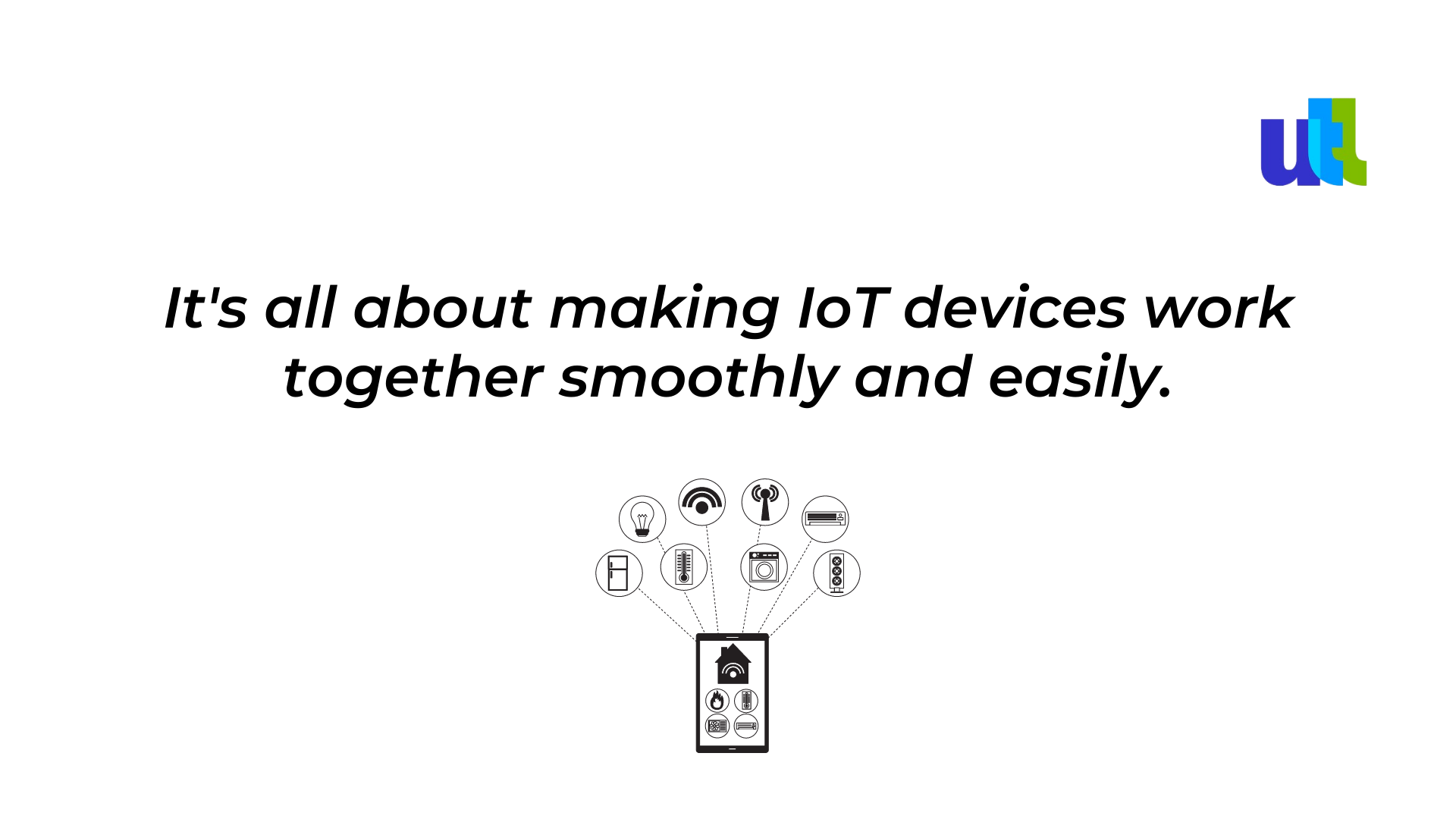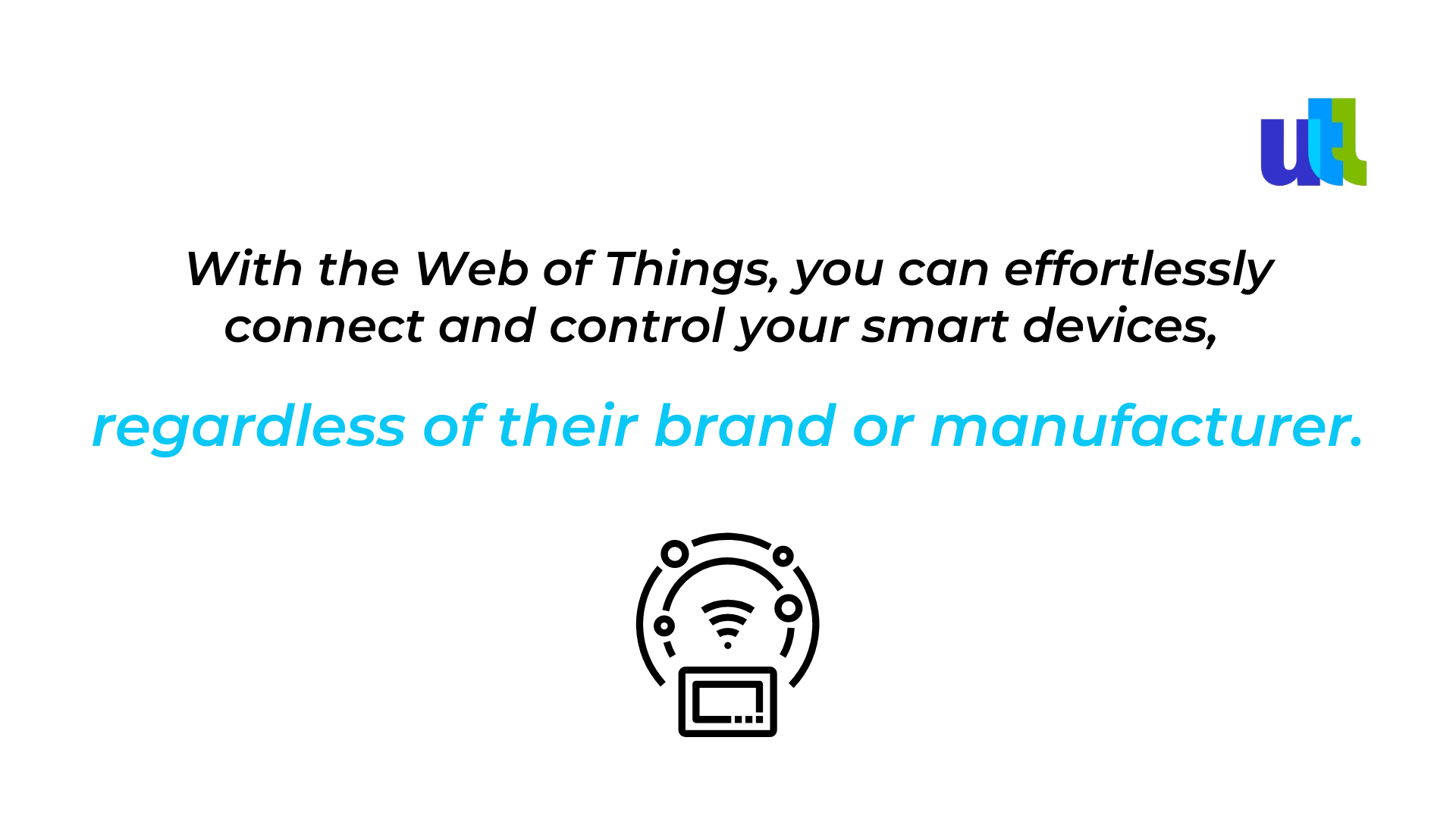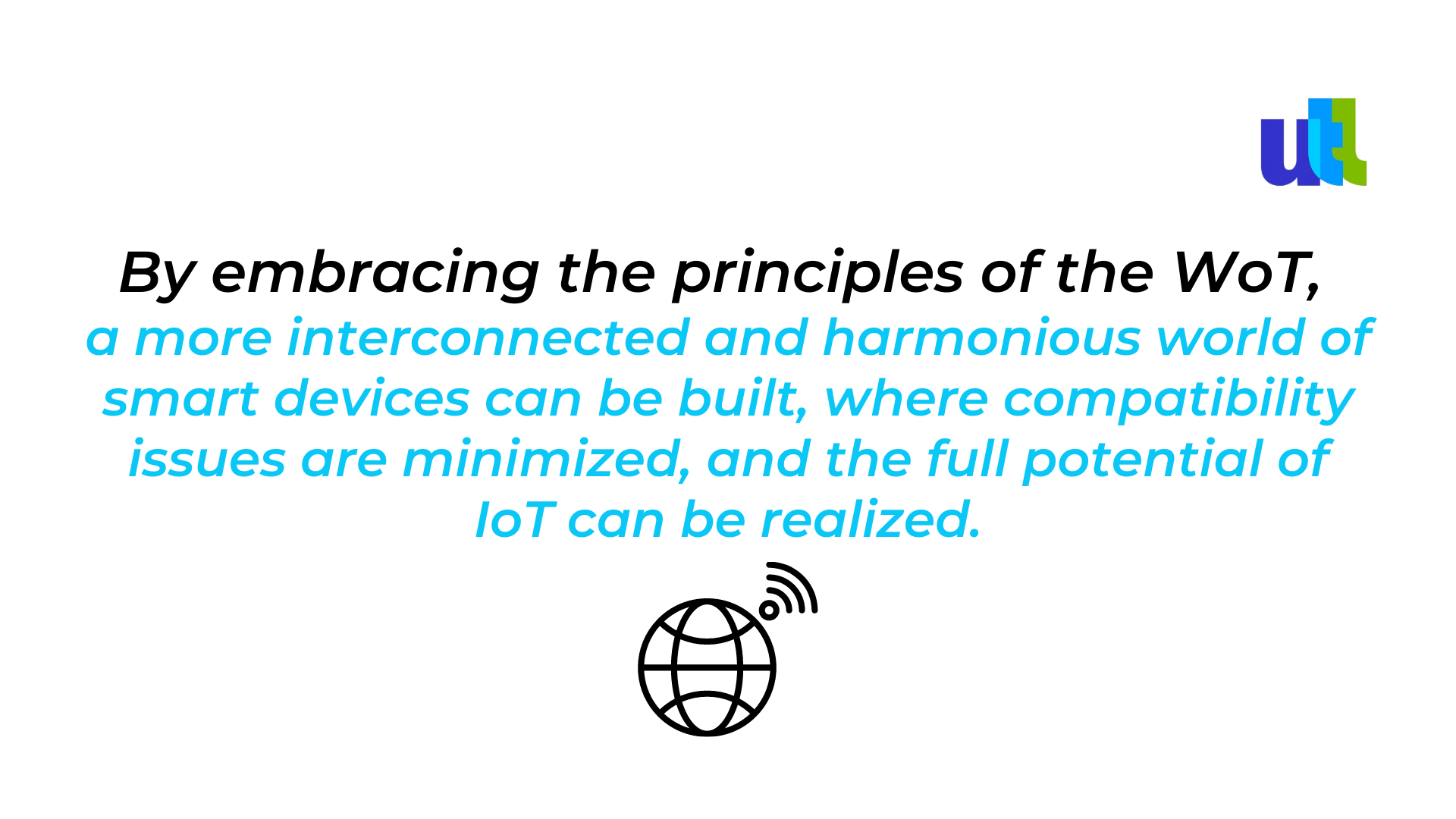The Web of Things (WoT) takes the Internet of Things (IoT) to new heights by seamlessly connecting smart devices not only to the internet but also to the vast web architecture.

As the IoT has grown rapidly, it has encountered challenges due to the diverse and unique designs of different devices. This fragmentation makes it difficult to connect them and often restricts users to products from a single company. It's like being locked into one brand, unable to mix and match devices due to compatibility issues. However, the Web of Things comes to the rescue by establishing universal standards that all IoT devices can adhere to.
In simpler terms, WoT allows your smart devices to communicate with each other seamlessly and also with web applications. It ensures compatibility and enhances the convenience and flexibility of your IoT experience.

It's all about simplifying your life and unlocking the true potential of the Internet of Things.
The Web of Things (WoT) shares some similarities with the Internet of Things (IoT), but it also brings significant differences to the table. Like the IoT, WoT involves connecting everyday devices to the web, enabling communication between them using various systems. However, WoT takes it a step further by emphasizing the integration of devices with the broader web infrastructure.

Where it all began
The idea of the Web of Things emerged in 2007 from the work of researchers. Since then, it has gained support and endorsement from notable organizations like Mozilla, Siemens, and the World Wide Web Consortium (W3C). These organizations have formed interest groups to establish the rules and standards that should govern the Web of Things. One important standard is the Web Thing Model, which provides a consistent way to share information about virtual or physical devices, also known as Things.
Although both IoT and Web of Things aim to connect smart devices through the internet, it's crucial to understand that they have some distinct differences. As mentioned by Mobidev, the main purpose is similar, but the approach and implementation vary.
In addition to the Web Thing Model, the collaborating groups have introduced several other standards to shape the Web of Things. These standards include the WoT Architecture, WoT Thing Description, WoT Scripting API, and WoT Binding Templates. Together, these components form the foundation of the Web of Things design, ensuring interoperability and smooth communication between devices and web applications.
Comparing IoT and WoT: Embracing the web for smart device connectivity
As we see more and more objects getting digital features, it's clear that the next step is to use the internet to connect these objects and create applications for the Internet of Things (IoT). Instead of each device having its own way of communicating and its own app, we can use the World Wide Web's infrastructure to connect them all. This idea is called the Web of Things (WoT). The great thing about WoT is that we can use the same technology that powers big websites like Facebook or Google to connect even the smallest devices, while still keeping them secure and fast. The main goal of the WoT is to make the most of existing web tools and techniques to build better IoT scenarios.
While IoT has focused on solving networking problems, WoT goes a step further by using application-level protocols and tools. By thinking in a web-oriented way, WoT doesn't rely on the specific networking technologies that devices use. Instead, it uses the power of the web to enhance IoT functionality.
It's important to understand the differences between IoT and WoT. IoT works at the network level, where devices can talk to each other. However, it doesn't handle data transmission or coordination between different sources very well. This becomes a problem when we need to send data to the right place or manage interactions between different data sources.
On the other hand, WoT works at the application level and improves IoT. It doesn't replace IoT, but builds on top of it. The main goal of WoT is to create standard ways of representing devices on the internet so that they can work together more easily.
To understand this better, think of IoT as the roads that connect different places, and WoT as the street signs, traffic lights, and planned routes that make sure everything runs smoothly. WoT ensures that data is transferred efficiently and reliably between different points, making sure it works well with both the source and destination of the data.
In conclusion, WoT takes IoT from just an idea to a complete architectural approach that makes it easier for smart devices to work together. By establishing common standards for communication, WoT enables better connectivity between IoT devices, leading to a more interconnected and intelligent world.
WoT architecture
The Web of Things (WoT) architecture is a way to connect IoT devices using the World Wide Web. The standardization of WoT is built upon several key elements: Thing Description, Binding Templates, Scripting API, and Security and Privacy Guidelines.
The Thing Description serves as the foundation for integrating IoT devices (referred to as "Things") into the Web of Things. It defines the metadata and interfaces that a Thing should provide, ensuring that the metadata is machine-readable and compliant with the standard.
Protocol Bindings refer to the protocols used for communication between IoT devices. These Binding templates help devices understand and communicate with each other even if they use different protocols.
The WoT Scripting API: This is a special programming language that helps IoT devices connect to the Web of Things. It's presented as a JSON API, which is a way for devices to talk to each other using a common language. While it's not necessary for all devices to use this programming language, it makes things easier because it allows applications to work on different platforms without too much trouble.
Security and Privacy Guidelines are of utmost importance in the Web of Things. Similar to how the Internet itself lacks specific safety guidelines for applications, the Internet of Things also faces security challenges. With the increasing threat of cyber-attacks and compromised personal electronic security, safeguarding data has become crucial. This is particularly critical when physical devices are connected to the internet, such as in homes, offices, or medical applications.
These four components—Thing Description, Protocol Bindings, WoT Scripting API, and Security and Privacy Guidelines—make up the core structure of the Web of Things. They ensure that IoT devices can connect, communicate, and stay secure in the Web of Things.
WoT use cases and applications
With the widespread adoption of the Internet of Things (IoT), you might wonder if there's a practical reason for the newer application layer called the Web of Things (WoT) in the real world. Well, the truth is that there are numerous practical use cases for WoT standards across different settings like commercial, residential, and industrial environments.
Let's start with smart homes. In everyday life, many people interact with WoT through smart home technologies. You might have heard of devices like smart thermostats, security cameras, or even door locks. All these devices need to work together smoothly to make our lives easier. WoT ensures that these devices can understand each other and work well together. It's like they speak the same language, and that's why you can control your smart home using a single app or even your voice!
But WoT isn't just for homes. It has benefits in commercial settings too. Think about factories and production facilities. With WoT, machines can be connected to the internet. This allows for automated production and remote monitoring of the production process. It's not just about efficiency; it also makes sure that the factory is safe and secure, just like our homes.
The potential of a standardized Internet of connected Things is truly limitless. WoT has applications in various industries like agriculture, logistics, construction, transportation, and even in our cities. These industries often depend on interconnected devices to keep things running smoothly. For example, in agriculture, smart sensors can monitor crops and help optimize irrigation. In logistics, connected devices can track packages and ensure they reach their destinations on time. WoT makes all these different industries work together seamlessly.
In summary, WoT has practical uses in our everyday lives. It makes our homes smarter, improves efficiency in factories, and even helps industries like agriculture and logistics. WoT opens up endless possibilities for enhancing safety, efficiency, and overall performance in various sectors.
Wearables and the Web of Things (WoT) are opening up amazing opportunities for creating new applications in different areas. By integrating wearable and quantified self-devices into the web, data becomes directly accessible to other devices and applications. This means we can create cool applications without needing separate apps for each device.
Let's look at Nike as an example. They've had great success with their wearable devices that focus on the social side of sports. Users can share and compare their personal data like race times and distances with others. The connection between these wearable devices and social networks on the web, made possible by WoT, makes the whole experience even better.
When it comes to smart homes and buildings, people have been talking about automating and personalizing living spaces for a long time. But with the Internet of Things, things have really taken off. Now, modern smart homes use internet-friendly protocols to connect devices directly to the web or through special gateways in our homes. This means we can do all sorts of amazing things with home automation and break free from using only specific systems.
In summary, when we combine wearables with the power of the Web of Things, we can create incredible applications in many different fields. We can improve our health, make our homes smarter, and even go beyond that. The possibilities are endless.
WoT challenges
While the Web of Things (WoT) aims to solve many challenges in the world of IoT, it also faces its own difficulties. It's important to understand that no technology is perfect, and there are always trade-offs to consider, even with all the benefits that WoT brings.
One major concern with WoT is security and privacy. Whenever something is connected to the internet, there's a risk of vulnerabilities in web applications that could lead to data breaches. This risk becomes even more significant when there's a direct connection to the physical world. The W3C has provided guidelines to help mitigate these risks, but since these guidelines are public, hackers could potentially find ways to exploit them. Additionally, when many devices follow the same standard, any weakness in that standard exposes all devices to the same vulnerability.
Another challenge is energy efficiency. In a fully integrated WoT home or business, multiple devices need to be constantly powered on to be ready when needed. This continuous operation requires energy, but steps can be taken to identify peak usage times and optimize device activity to reduce energy consumption. However, for certain use cases like security and safety systems, constant availability is crucial.
Unfortunately, the need for continuous availability also introduces a risk of failure. Denial-of-service (DoS) attacks can make devices inoperable, even if they are always powered on. In a DoS attack, hackers flood a device with signals, overwhelming its resources and preventing legitimate requests from being processed. This attack can lock legitimate users out of their devices or even cause the devices to crash, as long as the attackers have enough resources to sustain the attack.
The positive side of WoT is that it's an open standard that is constantly evolving and being improved by technical experts in various fields, including security. This ongoing innovation allows security concerns and drawbacks to be addressed over time as the standards progress. Moreover, the diligent efforts already made in establishing WoT's security guidelines have helped mitigate many of these risks.
In conclusion, while WoT brings numerous advantages, it's crucial to acknowledge and address the challenges it poses. By actively working on improving security measures and tackling drawbacks, WoT continues to evolve as an open standard, ensuring that the benefits outweigh the risks.
The future of WoT
The Internet of Things (IoT) has changed the way we see devices connected to the internet. It's not just computers anymore; now, all sorts of devices, appliances, and tools can be made better by connecting them to the internet. This has become even more advanced with the Web of Things.
As smart devices become increasingly capable and their adoption grows, the need for standardized communication between devices becomes crucial. This demand continues to escalate as more devices are being connected to the internet every day. This is where the Web of Things comes into play, guiding the evolving landscape of smart devices towards common protocols for seamless interconnectivity.
You may have heard about the latest protocol called Matter, designed to simplify the connection between different smart home devices. This standardization will contribute to the further development of the Web of Things, aligning with the ongoing trends in web technology.
As more device makers use the Web of Things, devices will become more powerful. They won't be stuck in one company's system, which means different companies will compete and make better devices. This will help smart homes, businesses, factories, and cities grow and become more efficient and affordable.
The future of the Web of Things looks bright. It will let devices communicate well and bring different groups of people together to work on making things better. With standard ways for devices to connect and work together, we can expect a world where many different smart devices make our lives better in lots of different ways.
For free consultation on WoT (Web of Things) and IoT click here.
----------------------------------------------------------------------------------------------
View the full presentation:
WRITTEN BY
Milda Butkeviciute
2023-07-17


































































































































































































